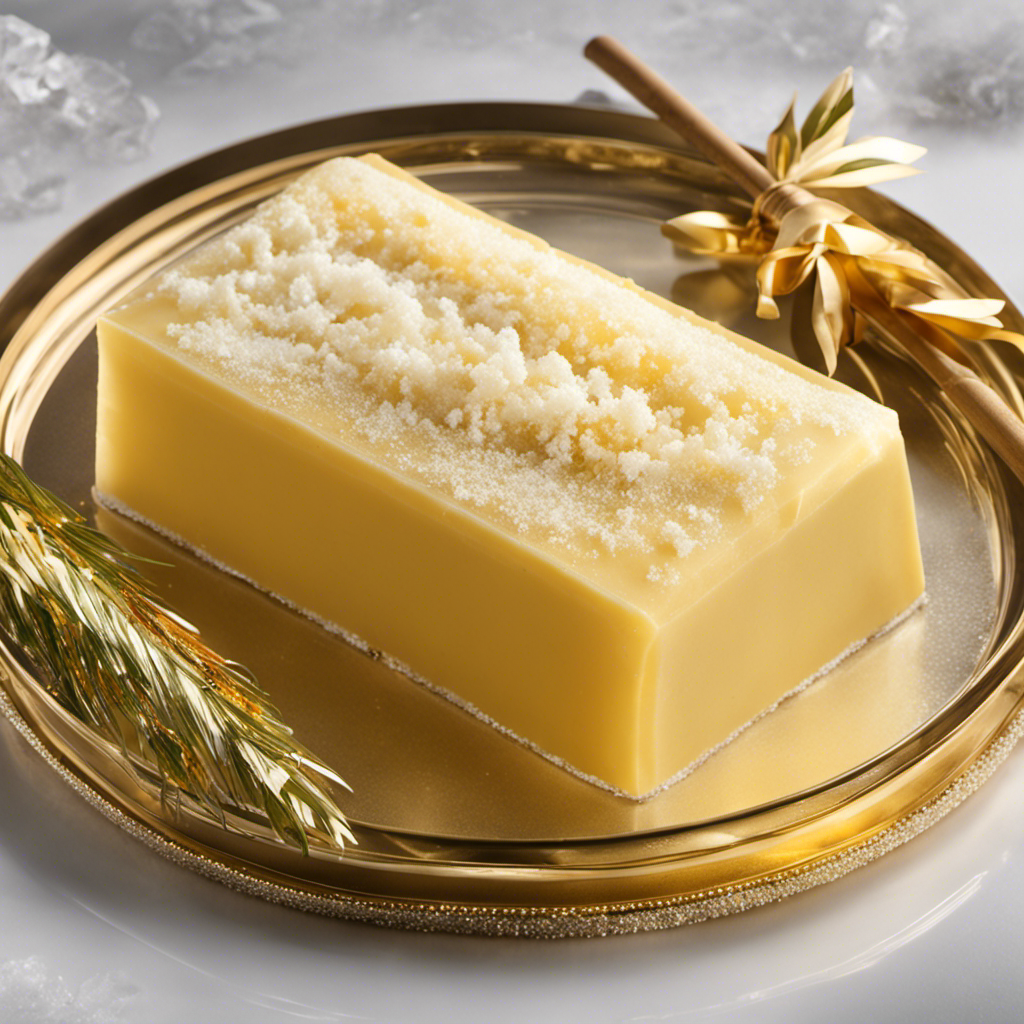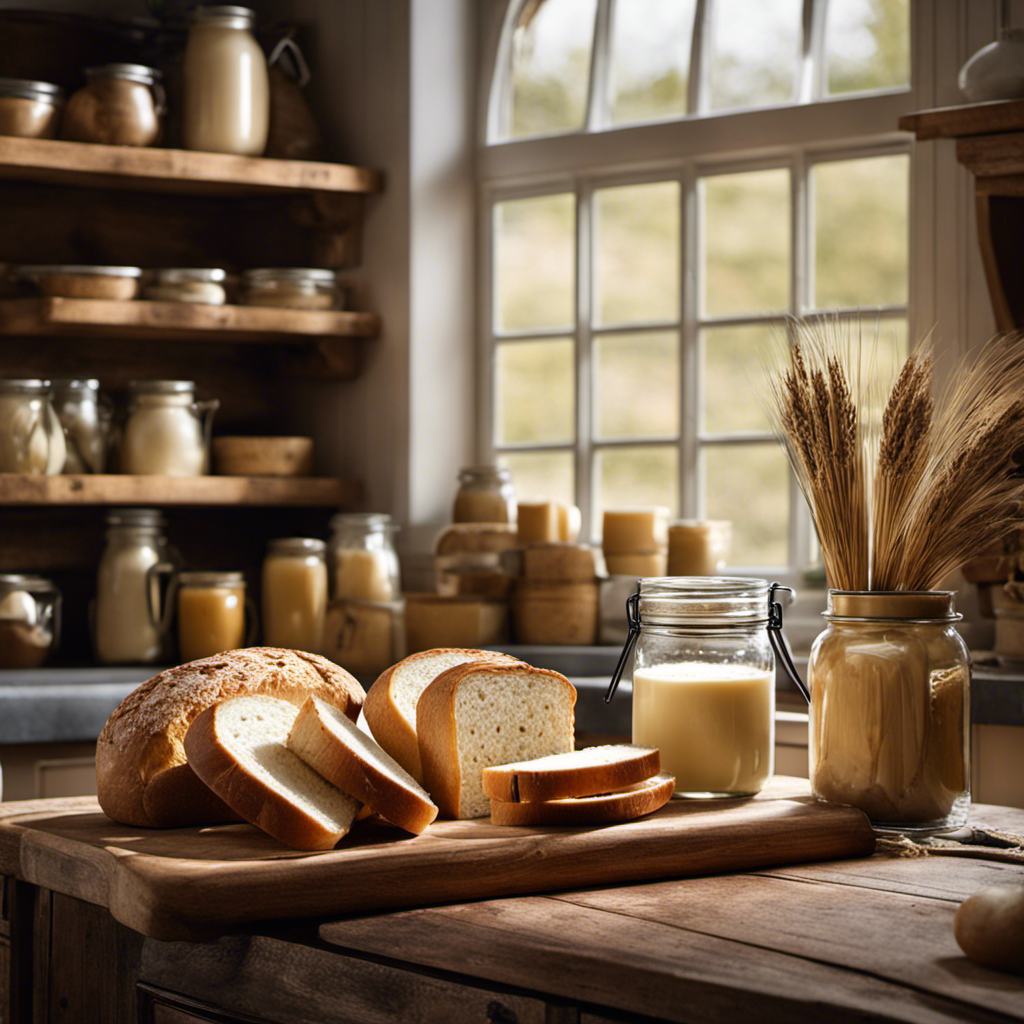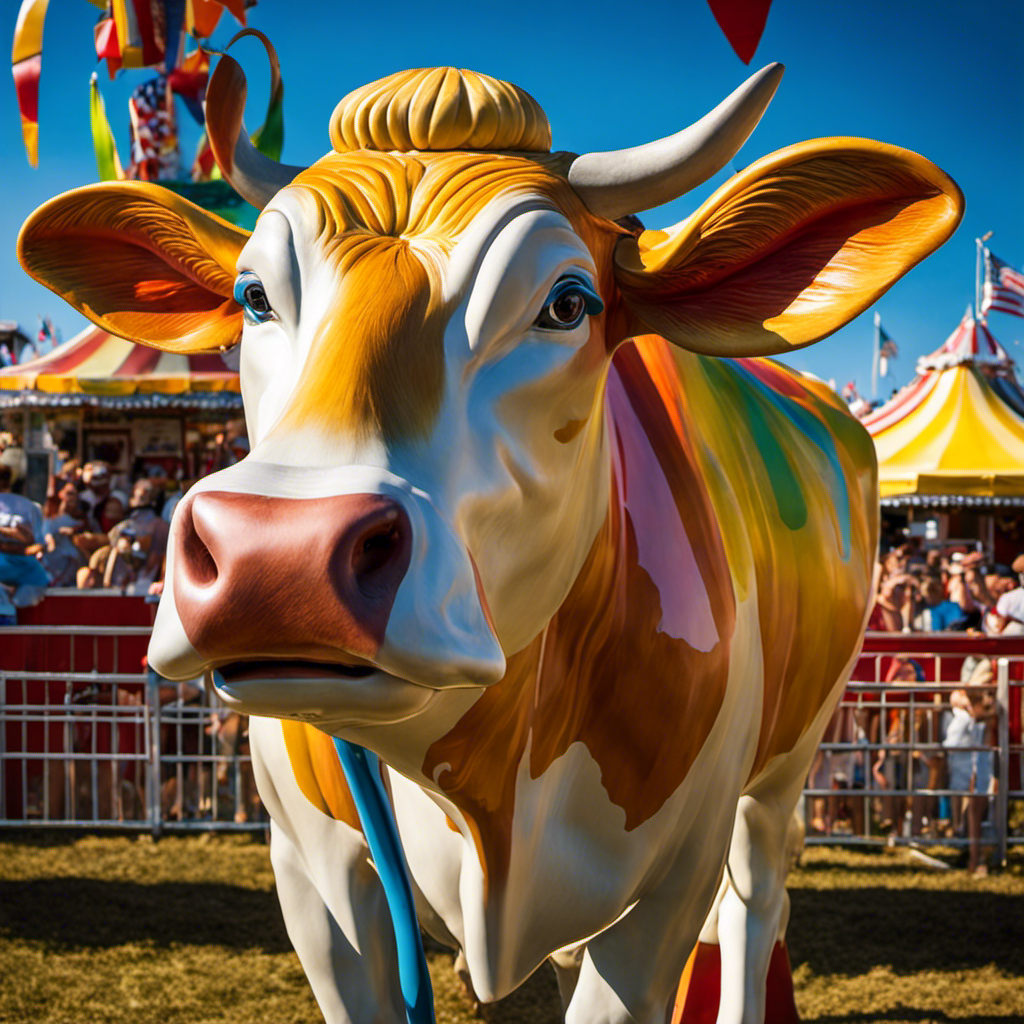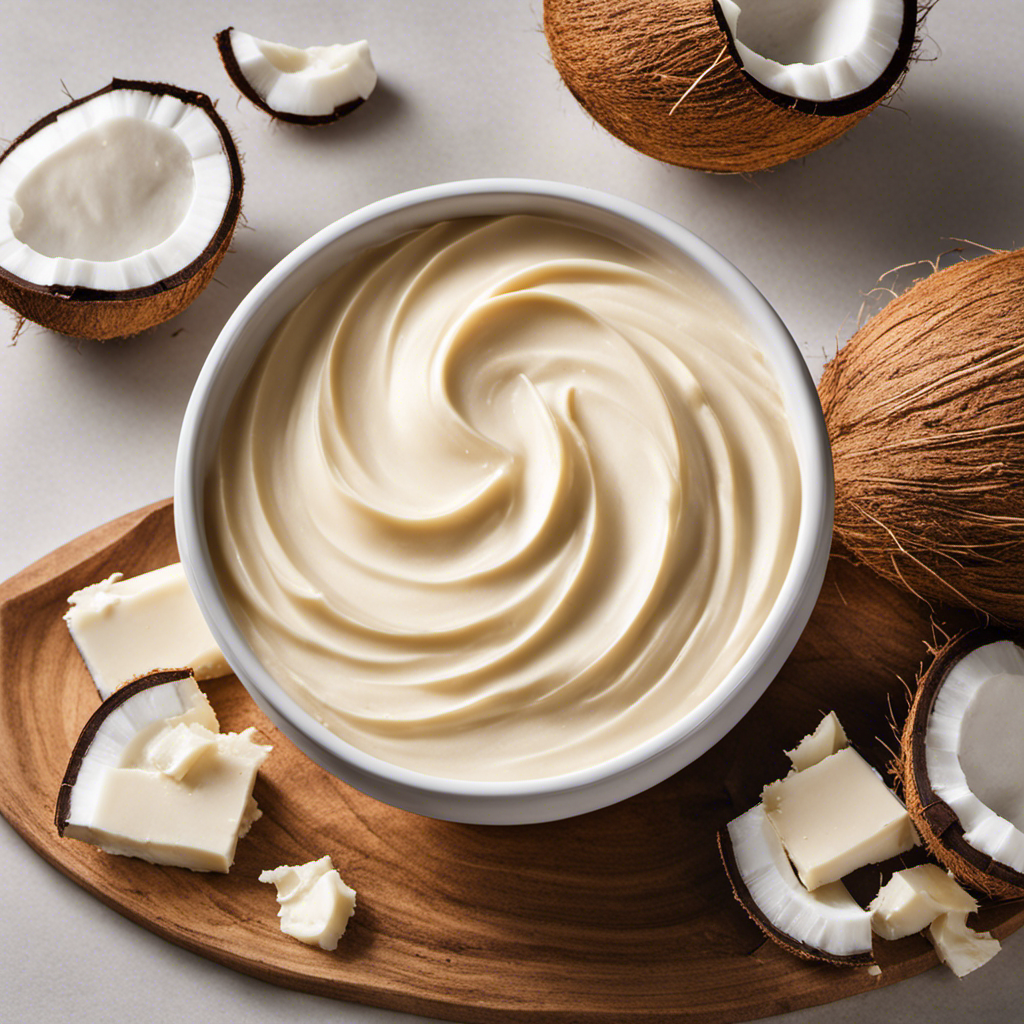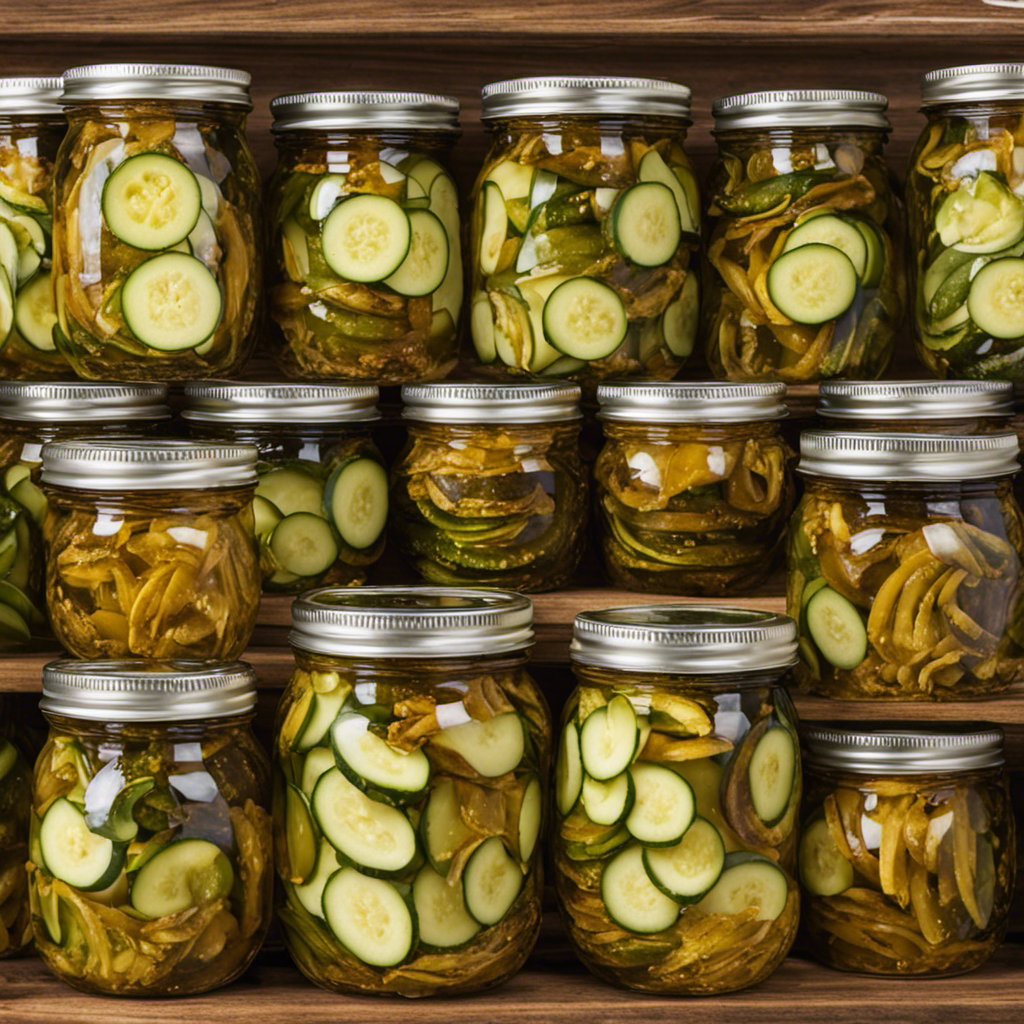I have always wondered how long butter can stay fresh in the freezer before losing its quality. So, I decided to do some research and find out the answer.
In this article, I’ll explore the ins and outs of freezing butter, from the proper storage containers to preventing freezer burn.
Join me as we delve into the world of butter freezing and discover the best ways to preserve this creamy delight for the long haul.
Key Takeaways
- Freezing butter extends its shelf life.
- Proper storage containers with airtight seals are crucial for maintaining freshness and preventing freezer burn.
- Butter should be divided into smaller portions before freezing for quicker thawing.
- Label containers with freezing date to track freshness.
Butter Freezing Basics
If you’re wondering about freezing butter, it’s important to know the basics.
Freezing butter is a great way to extend its shelf life and ensure that you always have some on hand.
To freeze butter properly, it’s recommended to wrap it tightly in plastic wrap or aluminum foil to prevent any air from getting in. This will help prevent freezer burn and keep the butter fresh for longer.
Another tip is to cut the butter into smaller portions before freezing, as it will thaw more quickly when you need it.
If you’re looking for alternatives to freezing butter, you can also try storing it in the refrigerator, where it can last for several weeks. However, freezing is the best option if you want to keep it for an extended period of time.
The Freezing Process
To freeze butter properly, ensure it is stored in an airtight container.
When it comes to freezing butter, it is important to understand the freezing process. Butter has a freezing temperature of around 32°F (0°C), which means it solidifies when exposed to temperatures below this point.
It is recommended to freeze butter in bulk, as it can be stored for an extended period of time without losing its quality. Freezing butter in bulk allows you to have a constant supply on hand, especially if you use it frequently in your cooking or baking endeavors.
When freezing butter in bulk, make sure to divide it into smaller portions for easier use later on.
Transitioning into the subsequent section about recommended storage containers, it is crucial to choose the right container to maintain the butter’s freshness and prevent freezer burn.
Recommended Storage Containers
When it comes to storing food in the freezer, the choice between plastic and glass containers is an important consideration.
Plastic containers are lightweight and less likely to break, but glass containers are more durable and can be reheated in the oven or microwave.
The importance of an airtight seal cannot be underestimated, as it helps to prevent freezer burn and maintain the quality of the food.
Plastic Vs. Glass
You should consider using glass containers instead of plastic containers to store your butter in the freezer. When it comes to choosing the right storage container, both glass and silicone have their own pros and cons.
Glass containers are known for their durability and ability to withstand extreme temperatures. They are also non-toxic and do not absorb odors or flavors from the butter. However, glass containers can be heavy and may break if mishandled.
On the other hand, silicone containers are lightweight, flexible, and easy to clean. They are also non-toxic and safe for use in the freezer. However, silicone containers may retain odors and flavors from the butter over time.
Ultimately, the choice between glass and silicone comes down to personal preference.
In the subsequent section, we will discuss the importance of an airtight seal in butter storage.
Airtight Seal Importance
An airtight seal is essential for maintaining the freshness and quality of stored food. When it comes to freezing food, such as butter, maintaining the ideal freezer temperature and controlling moisture are crucial factors. Freezing butter at a temperature of 0°F (-18°C) or below ensures that it remains safe to eat for an extended period. However, without a proper airtight seal, the butter can be exposed to air and moisture, leading to freezer burn and loss of quality. Moisture control is equally important, as excess moisture can cause the butter to become rancid or develop off-flavors. To illustrate the importance of an airtight seal and proper freezer storage, here is a table showcasing the effects of different storage methods on the quality of frozen butter:
| Storage Method | Quality of Frozen Butter |
|---|---|
| Airtight Container | Fresh and Flavorful |
| Plastic Wrap | Risk of Freezer Burn |
| Open Container | Loss of Quality and Flavor |
Freezer Burn Prevention
Now that we understand the importance of an airtight seal when freezing butter, let’s delve into freezer burn prevention and how it can help prolong the freshness of butter.
Freezer burn occurs when the moisture in the butter evaporates, leading to dehydration and oxidation. To prevent freezer burn, it’s crucial to store butter in airtight containers or freezer bags.
Wrapping the butter tightly in aluminum foil or plastic wrap before placing it in the container can provide an additional layer of protection. It’s also advisable to label the containers with the date of freezing to keep track of its freshness.
Moreover, maintaining a consistently low temperature in the freezer and rotating the butter regularly can further prevent freezer burn and ensure that your butter stays fresh for a longer period.
Preparing Butter for Freezing
When it comes to freezing butter, it is important to consider the different methods available.
In order to preserve its quality and flavor, it is recommended to use airtight containers or bags specifically designed for freezing.
These containers will help protect the butter from freezer burn and maintain its freshness for a longer period of time.
Butter Freezing Methods
You can freeze butter by wrapping it tightly in plastic wrap or placing it in an airtight container.
When it comes to freezing butter, there are a few tips and equipment that can help ensure the best results.
Firstly, make sure to use fresh, high-quality butter for freezing. This will help maintain its flavor and texture when thawed.
Secondly, choose a suitable container or wrapping material that is freezer-safe and prevents the butter from being exposed to air, which can cause freezer burn. Plastic wrap or airtight containers are ideal for this purpose.
It is also recommended to label the frozen butter with the date of freezing to keep track of its storage time.
Following these butter freezing tips and using the right equipment will help preserve the quality of your butter for an extended period.
Recommended Storage Containers
To ensure the best results, it’s important to choose appropriate storage containers for your frozen butter. When it comes to storing butter in the freezer, using the right containers can make a significant difference in maintaining its quality and preventing freezer burn.
I recommend using airtight, freezer-safe containers or resealable plastic bags specifically designed for freezing food. These containers will protect your butter from exposure to air and moisture, which can lead to flavor deterioration and texture changes.
It’s essential to avoid using containers made of materials that are not freezer-safe, such as glass jars or regular plastic containers, as they may crack or break due to temperature fluctuations.
Additionally, using alternative butter storage methods, such as wrapping it tightly in aluminum foil or using vacuum-sealed bags, can also help preserve its freshness and taste.
Proper Labeling and Dating
Labeling and dating your frozen butter is essential to ensure its freshness and prevent confusion in the future. Proper butter labeling tips and dating practices are crucial for maintaining the quality of the frozen butter.
Here are some important guidelines to follow:
- Label the packaging clearly with the date of freezing to keep track of how long the butter has been stored.
- Include any additional information, such as the type of butter or the source, to avoid mix-ups and provide helpful details for future use.
- Use waterproof markers or labels to prevent smudging or fading, ensuring the information remains legible over time.
Maximum Freezing Time for Fresh Butter
When it comes to freezing butter, there are limits to how long it can be stored before quality begins to degrade.
It is important to understand the optimal storage conditions for butter in order to preserve its quality and taste.
In this discussion, we will explore the freezing limits of butter, the best ways to store it, and techniques for preserving its quality over time.
Butter Freezing Limits
You can freeze butter for up to six months without compromising its quality. Freezing butter is a great way to extend its shelf life and ensure that you always have some on hand. Here are some key points to consider when it comes to freezing butter:
-
Freezing butter alternatives: If you don’t have enough space in your freezer or prefer not to freeze butter, there are alternative options. You can store butter in the refrigerator for up to one month, or you can clarify the butter and store it in the refrigerator for up to six months.
-
Butter freezing effects: While freezing butter does not affect its taste or texture significantly, it may cause some separation between the milk solids and the butterfat. However, this can be easily remedied by stirring the butter after it thaws.
-
Optimal butter storage: After freezing, it is best to store butter in an airtight container or wrap it tightly in plastic wrap to prevent freezer burn and to maintain its freshness.
Optimal Butter Storage
To maintain the freshness of your butter, it’s important to store it in an airtight container or tightly wrap it in plastic wrap after it has been frozen. Proper butter freezing techniques can help preserve its flavor and texture for an extended period.
When freezing butter, it’s essential to ensure that it is at its freshest state, as any off-flavors or odors will become more pronounced during freezing. The ideal butter storage temperature is below 0°F (-18°C) to prevent the growth of bacteria and maintain its quality.
Butter Quality Preservation
Storing butter in an airtight container or tightly wrapping it in plastic wrap helps maintain its freshness and quality. When it comes to freezing butter, there are a few techniques and tips that can ensure its optimal preservation.
- Choose unsalted butter: Salt can affect the flavor and texture of butter during freezing.
- Cut into smaller portions: Divide the butter into smaller chunks or cubes for easier thawing and to prevent wastage.
- Use freezer-safe containers: Opt for containers specifically designed for freezer storage to minimize the risk of freezer burn and maintain the butter’s quality.
By following these butter freezing techniques and storage tips, you can enjoy the convenience of having butter readily available while preserving its taste and texture.
Remember to label the containers with the date to keep track of its freezing duration.
Freezing Salted Vs. Unsalted Butter
If you’re unsure about whether to freeze salted or unsalted butter, it’s important to consider the intended use and flavor profile of the butter.
Freezing salted butter is straightforward, as salt acts as a preservative. Simply wrap it tightly in a plastic wrap or place it in an airtight container before putting it in the freezer.
On the other hand, freezing unsalted butter requires a slightly different approach. To prevent the butter from absorbing any unpleasant odors or flavors, it is best to wrap it tightly in a plastic wrap and then place it in a freezer bag. This double-layer protection will ensure the butter stays fresh and unaffected by other freezer odors.
Thawing Frozen Butter
When it comes to thawing frozen butter, there are a few techniques that can be used to ensure optimal softening. Here are three methods you can try:
-
Room Temperature Method:
- Place the frozen butter on a plate or cutting board and leave it at room temperature.
- This method can take anywhere from 30 minutes to an hour, depending on the temperature of your kitchen.
- Avoid using a microwave or hot water to thaw the butter, as this can result in uneven softening.
-
Grating Method:
- Take the frozen butter and grate it using a cheese grater.
- The smaller surface area of the grated butter allows it to soften more quickly.
- This method is ideal if you need softened butter for a recipe that requires it to be mixed with other ingredients.
-
Microwave Method:
- Cut the frozen butter into smaller pieces and place them in a microwave-safe dish.
- Microwave the butter in short bursts of 5-10 seconds, checking and stirring in between, until it reaches the desired softness.
- Be careful not to melt the butter completely.
By utilizing these thawing techniques, you can successfully soften your frozen butter for use in various recipes.
Now, let’s explore how frozen butter can be incorporated into your cooking endeavors.
Utilizing Frozen Butter in Recipes
When it comes to cooking with frozen butter, it’s important to understand the proper storage methods and the benefits of freezing.
By storing butter in a freezer-safe container or wrapping it tightly in foil or plastic wrap, you can maintain its quality and prevent freezer burn.
Freezing butter also offers the advantage of extended shelf life, allowing you to have a ready-to-use ingredient on hand whenever you need it.
Cooking With Frozen Butter
To cook with frozen butter, you can simply thaw it in the refrigerator overnight. Once thawed, the butter can be used in a variety of cooking techniques to enhance the flavor of your dishes while preserving its unique taste. Here are some ways to utilize frozen butter in your recipes:
-
Sauteing: Melt the thawed butter in a pan and use it to sauté vegetables or proteins, adding a rich and buttery flavor to your dishes.
-
Baking: Incorporate the softened butter into your dough or batter for flaky pastries or moist cakes.
-
Sauce making: Add the melted butter to create a smooth and velvety texture in sauces like hollandaise or beurre blanc.
Butter Storage Methods
In order to preserve butter and extend its shelf life, it is important to store it properly. The storage temperature for butter plays a crucial role in maintaining its quality. Ideally, butter should be stored at a temperature between 32°F and 40°F (0°C and 4°C). This ensures that the butter remains solid and does not become too soft or prone to spoilage.
Additionally, the storage duration of butter is also important. Unsalted butter can be safely stored in the refrigerator for up to three months, while salted butter can last for up to five months. However, it is worth noting that butter can absorb odors from other foods in the refrigerator, so it is best to store it in an airtight container.
Transitioning into the next section, let’s explore the benefits of freezing butter.
Benefits of Freezing
One of the benefits of freezing butter is that it can extend its shelf life. When butter is frozen, it can be stored for a longer period of time without spoiling.
Here are some key points to consider about freezing butter:
-
Freezing duration: Butter can be stored in the freezer for up to 6 months without significant changes in quality. It’s important to properly wrap the butter to prevent freezer burn and off-flavors.
-
Flavor retention: When butter is frozen, it retains its flavor quite well. However, it’s important to note that long-term freezing may cause some subtle changes in taste and texture.
-
Proper packaging: To maintain the best quality, it is recommended to wrap butter tightly in plastic wrap or aluminum foil before placing it in a freezer bag or airtight container.
Overall, freezing butter can be a convenient way to extend its shelf life while still preserving its flavor, as long as proper storage techniques are followed.
Butter’s Texture and Quality After Freezing
You should be aware that freezing butter for an extended period may result in a change in its texture and quality. Proper butter freezing techniques are crucial for preserving its quality.
When freezing butter, it is important to wrap it tightly in airtight packaging, such as plastic wrap or freezer bags, to prevent freezer burn and off-flavors. It is also recommended to label the packaging with the date of freezing to keep track of its freshness.
Freezing butter at a temperature of 0°F (-18°C) or below helps to maintain its quality for a longer period. However, it is important to note that freezing can cause butter to become harder and more crumbly. To restore its original texture, allow the frozen butter to thaw in the refrigerator for a few hours before using it.
Storing Butter in the Freezer Long-Term
To maintain the quality of your frozen butter over an extended period, it is essential to store it properly in the freezer. Freezing butter is a great way to extend its shelf life, but there are both pros and cons to consider.
Here is a breakdown of the benefits and drawbacks of freezing butter versus refrigerating it:
-
Pros of freezing butter:
-
Longer shelf life: Butter can be frozen for up to 6-9 months without significant quality loss.
-
Convenient for bulk purchases: If you buy butter in bulk, freezing it allows you to store it for future use.
-
Retains flavor and texture: When properly stored, frozen butter maintains its taste and texture.
-
Cons of freezing butter:
-
Potential for flavor loss: Over time, frozen butter may lose some of its flavor.
-
Texture changes: Freezing can cause butter to become slightly grainy or crumbly once thawed.
-
Limited uses: Frozen butter is best suited for baking and cooking, as it may not spread easily when cold.
Tips for Preventing Freezer Burn
Properly storing your frozen butter in the freezer can help prevent freezer burn and maintain its quality. Freezer burn occurs when moisture inside the butter evaporates, resulting in dry, discolored patches.
To prevent freezer burn, it is important to wrap the butter tightly in plastic wrap or aluminum foil to prevent exposure to air. Additionally, placing the wrapped butter in a freezer-safe container or bag can provide an extra layer of protection.
When it comes to the duration of freezing butter, it is recommended to use it within 6-9 months for optimal quality. After this period, the butter may still be safe to consume, but its quality may deteriorate.
Taking these precautions can help ensure that your frozen butter remains fresh and free from freezer burn.
Now, let’s discuss some important safety measures to consider when freezing butter.
Butter Freezing Safety Measures
When storing butter in the freezer, it’s crucial to wrap it tightly in plastic wrap or aluminum foil to prevent freezer burn. Freezer burn occurs when moisture is lost from the butter, causing it to become dry and develop off-flavors.
To ensure the safety and quality of your frozen butter, consider the following measures:
-
Temperature: Set your freezer to a temperature of 0°F (-18°C) or lower to maintain the butter’s freshness and prevent bacterial growth.
-
Duration: Butter can be safely stored in the freezer for up to 6 months. Beyond this time, it may start to develop rancidity or lose its quality.
-
Packaging: Use airtight containers or freezer bags to further protect the butter from exposure to air and moisture.
Butter Storage Alternatives to Freezing
One alternative for storing butter without freezing is using a butter bell. A butter bell is a traditional French method of keeping butter fresh and spreadable at room temperature. It consists of a small pottery dish and a lid that create an airtight seal, protecting the butter from exposure to air and odors. The butter is placed in the dish and the lid is filled with water, creating a seal. This method allows the butter to stay fresh for up to a month without refrigeration. It is a great option for those who prefer not to freeze their butter but still want to keep it soft and ready to spread. Other butter storage alternatives include using a butter dish with a lid, wrapping the butter in wax paper or parchment paper, or using a butter keeper. These butter storage hacks can help prolong the freshness and quality of your butter.
| Butter Storage Alternatives |
|---|
| Butter Bell |
| Butter Dish with Lid |
| Wax Paper/Parchment Paper |
| Butter Keeper |
| Refrigeration |
Frequently Asked Questions
Can I Freeze Flavored or Infused Butter?
Yes, you can freeze flavored or infused butter. Freezing butter with herbs or spices helps preserve their flavors. Make sure to wrap it tightly in plastic wrap or an airtight container to prevent freezer burn.
How Long Can I Keep Frozen Butter in the Fridge After Thawing?
After thawing, I’ve learned that you should keep frozen butter in the fridge for about a month. To properly thaw it, place it in the fridge overnight or use the defrost setting on your microwave.
Can I Freeze Butter in Its Original Packaging?
Yes, you can freeze both salted and unsalted butter in its original packaging. However, it’s recommended to wrap it in an airtight container or freezer bag for longer storage.
Is It Safe to Freeze Butter in a Plastic Container?
It’s not safe to freeze butter in a plastic container. Use alternatives like freezer bags or airtight containers. To prevent freezer burn, wrap the butter tightly in foil or wax paper before freezing.
Can I Freeze Whipped Butter?
Yes, you can freeze whipped butter. However, it may change in texture and consistency after thawing. For best results, freeze salted and unsalted butter in airtight containers, ensuring they are properly labeled and dated.
Conclusion
In conclusion, freezing butter is a convenient way to extend its shelf life and ensure its freshness for longer periods. By following the proper freezing process, using the recommended storage containers, and labeling the butter correctly, you can store it in the freezer for several months without sacrificing its quality.
However, it is important to take precautions to prevent freezer burn and ensure butter freezing safety. So, next time you have an abundance of butter, don’t hesitate to freeze it for future use. Your taste buds will thank you!
And remember, time flies when you’re having fun, just like butter in the freezer!
